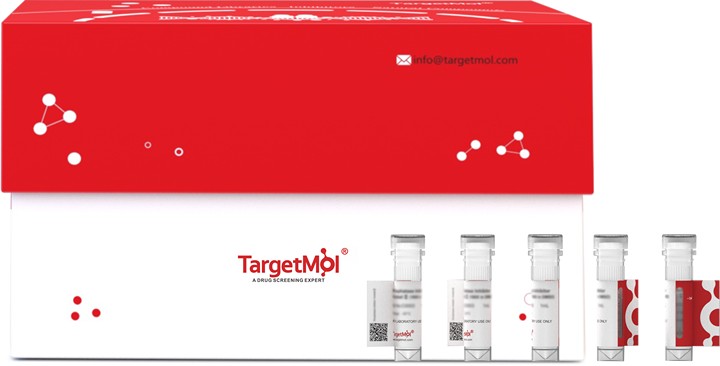

IL23R, also known as the IL23 receptor, belongs to the type I cytokine receptor family, Type 2 subfamily. It contains 2 fibronectin type-III domains and is expressed by monocytes, Th1, Th0, NK, and dendritic cells. Isoform 1 is specifically expressed in NK cells. IL23R associates with IL12RB1 to form the interleukin-23 receptor. It binds IL23 and mediates T-cells, NK cells, and possibly certain macrophage/myeloid cell stimulation probably through activation of the Jak-Stat signaling cascade. IL23 functions in innate and adaptive immunity and may participate in acute response to infection in peripheral tissues. IL23 may be responsible for autoimmune inflammatory diseases and be important for tumorigenesis. Genetic variations in IL23R are associated with inflammatory bowel disease type 17 (IBD17). IBD17 is a chronic, relapsing inflammation of the gastrointestinal tract with a complex etiology. Genetic variations in IL23R also can cause susceptibility to psoriasis type 7.

| Pack Size | Availability | Price/USD | Quantity |
|---|---|---|---|
| 100 μg | In stock | $ 386.00 | |
| 200 μg | 5 days | $ 682.00 | |
| 500 μg | 5 days | $ 1,440.00 |
| Biological Information | Testing in progress |
| Description | IL23R, also known as the IL23 receptor, belongs to the type I cytokine receptor family, Type 2 subfamily. It contains 2 fibronectin type-III domains and is expressed by monocytes, Th1, Th0, NK, and dendritic cells. Isoform 1 is specifically expressed in NK cells. IL23R associates with IL12RB1 to form the interleukin-23 receptor. It binds IL23 and mediates T-cells, NK cells, and possibly certain macrophage/myeloid cell stimulation probably through activation of the Jak-Stat signaling cascade. IL23 functions in innate and adaptive immunity and may participate in acute response to infection in peripheral tissues. IL23 may be responsible for autoimmune inflammatory diseases and be important for tumorigenesis. Genetic variations in IL23R are associated with inflammatory bowel disease type 17 (IBD17). IBD17 is a chronic, relapsing inflammation of the gastrointestinal tract with a complex etiology. Genetic variations in IL23R also can cause susceptibility to psoriasis type 7. |
| Species | Human |
| Expression System | HEK293 |
| Tag | His |
| Accession Number | AAM44229.1 |
| Synonyms | interleukin 23 receptor |
| Construction | A DNA sequence encoding the human IL23R (AAM44229.1) (Met1-Asp353) was expressed with a polyhistidine tag at the C-terminus. |
| Protein Purity |
> 95 % as determined by SDS-PAGE. > 85 % as determined by SEC-HPLC.
|
| Molecular Weight | Approxiamtely 39.3 kDa |
| Endotoxin | < 1.0 EU per μg of the protein as determined by the LAL method. |
| Formulation | Lyophilized from sterile PBS, pH 7.4. Please contact us for any concerns or special requirements. Normally 5 % - 8 % trehalose, mannitol and 0. 01% Tween 80 are added as protectants before lyophilization. Please refer to the specific buffer information in the hard copy of CoA. |
| Reconstitution | A hardcopy of datasheet with reconstitution instructions is sent along with the products. Please refer to it for detailed information. |
| Stability & Storage |
Samples are stable for up to twelve months from date of receipt at -20℃ to -80℃. Store it under sterile conditions at -20℃ to -80℃. It is recommended that the protein be aliquoted for optimal storage. Avoid repeated freeze-thaw cycles. |
| Shipping |
In general, recombinant proteins are provided as lyophilized powder which are shipped at ambient temperature.Bulk packages of recombinant proteins are provided as frozen liquid. They are shipped out with blue ice unless customers require otherwise. |
| Research Background | IL23R, also known as the IL23 receptor, belongs to the type I cytokine receptor family, Type 2 subfamily. It contains 2 fibronectin type-III domains and is expressed by monocytes, Th1, Th0, NK, and dendritic cells. Isoform 1 is specifically expressed in NK cells. IL23R associates with IL12RB1 to form the interleukin-23 receptor. It binds IL23 and mediates T-cells, NK cells, and possibly certain macrophage/myeloid cell stimulation probably through activation of the Jak-Stat signaling cascade. IL23 functions in innate and adaptive immunity and may participate in acute response to infection in peripheral tissues. IL23 may be responsible for autoimmune inflammatory diseases and be important for tumorigenesis. Genetic variations in IL23R are associated with inflammatory bowel disease type 17 (IBD17). IBD17 is a chronic, relapsing inflammation of the gastrointestinal tract with a complex etiology. Genetic variations in IL23R also can cause susceptibility to psoriasis type 7. |
bottom
Please read the User Guide of Recombinant Proteins for more specific information.
IL-23R Protein, Human, Recombinant (His) interleukin 23 receptor recombinant recombinant-proteins proteins protein
